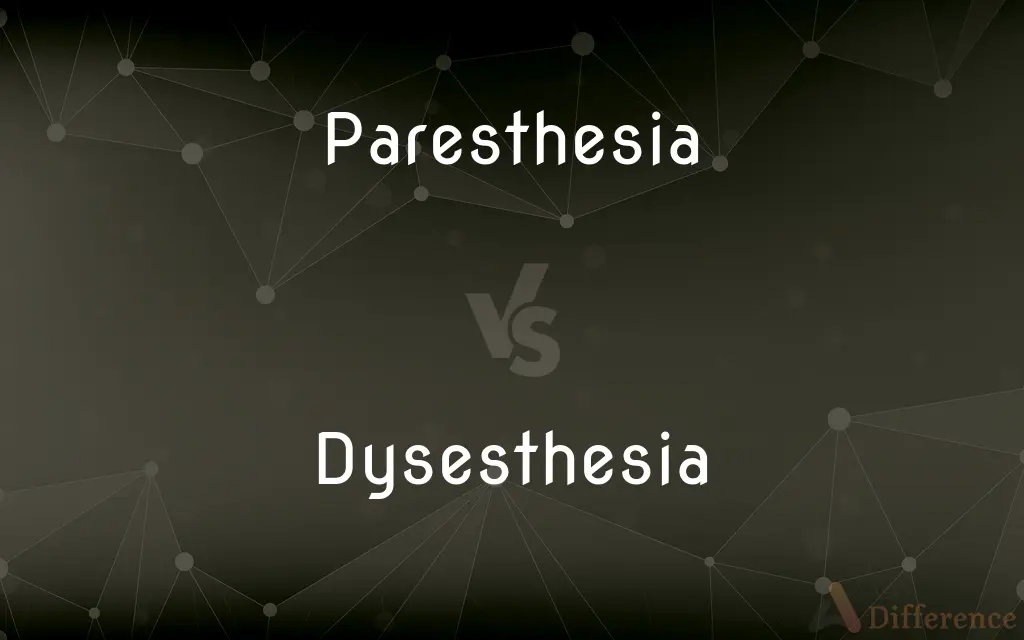Paresthesia vs. Dysesthesia — What's the Difference?
By Tayyaba Rehman — Updated on September 30, 2023
Paresthesia refers to abnormal sensations like tingling or numbness, usually harmless. Dysesthesia is unpleasant, abnormal sensations, often painful, resulting from nerve damage.

Difference Between Paresthesia and Dysesthesia
Table of Contents
ADVERTISEMENT
Key Differences
Paresthesia and Dysesthesia are both neurological symptoms but differ primarily in experience and implication. Paresthesia often manifests as the ‘pins and needles’ sensation or numbness, typically transient and benign, often due to pressure on nerves. Dysesthesia, on the other hand, is characterized by distressing and uncomfortable sensations, usually painful, often correlated with conditions affecting the nervous system such as multiple sclerosis or neuropathy.
Paresthesia is typically a transient phenomenon, often resolving itself once the pressure on the nerve is relieved, such as changing positions when a limb “falls asleep”. It is usually not associated with any underlying pathological condition and is mostly harmless. Dysesthesia, conversely, is more persistent and indicative of potential nerve damage or a neurological condition and typically requires medical evaluation and management due to its distressing nature.
While Paresthesia can occur in various parts of the body like legs, arms, and fingers, causing tingling, numbness, or prickling sensations, Dysesthesia is usually localized and can result in burning, aching, or a raw sensation, which is typically more severe and troublesome. The sensations in Dysesthesia are often provoked by stimuli that shouldn’t cause pain, like a light touch, highlighting the abnormal response of the sensory nerves.
The occurrence of Paresthesia is common and generally doesn’t require any treatment as it is usually momentary and harmless. In contrast, Dysesthesia, due to its chronic and painful nature, often necessitates medical intervention and management, involving medications, physical therapy, or other treatments aimed at the underlying condition causing the abnormal sensations.
In summary, Paresthesia is characterized by temporary and usually benign abnormal sensations like tingling or numbness, typically caused by pressure on nerves, whereas Dysesthesia is distinguished by chronic, often painful abnormal sensations, usually indicative of underlying neurological conditions or nerve damage, necessitating medical evaluation and treatment.
ADVERTISEMENT
Comparison Chart
Sensation
Abnormal but usually harmless sensations.
Distressing, often painful, abnormal sensations.
Cause
Often transient pressure on nerves.
Usually due to nerve damage or neurological condition.
Duration
Typically transient and momentary.
More chronic and persistent.
Treatment
Usually not required.
Often requires medical intervention.
Associated Conditions
Rarely associated with pathological conditions.
Often indicative of underlying neurological disorders.
Compare with Definitions
Paresthesia
A sensation of tingling or numbness, usually transient.
Sitting in one position for too long can lead to paresthesia in the legs.
Dysesthesia
Unpleasant, abnormal sensations, usually painful.
Patients with neuropathy often experience dysesthesia.
Paresthesia
Typically harmless sensations due to pressure on nerves.
Paresthesia in the foot is common after sitting cross-legged for extended periods.
Dysesthesia
Abnormal painful response to stimuli, often due to nerve damage.
Dysesthesia can make a gentle touch feel painfully burning.
Paresthesia
Occasional numbness or prickling sensations, usually temporary.
Paresthesia is a common sensation and usually resolves without intervention.
Dysesthesia
Disturbing and persistent sensory experiences, often requiring treatment.
Managing dysesthesia often involves addressing the underlying condition causing it.
Paresthesia
Abnormal sensations often described as ‘pins and needles’.
He experienced paresthesia in his arm after resting his head on it.
Dysesthesia
Distressing sensations often indicative of neurological conditions.
Dysesthesia in multiple sclerosis can be extremely discomforting for patients.
Paresthesia
Non-painful abnormal sensory experiences, often reversible.
Shaking the hand often alleviates paresthesia caused by leaning on the arm.
Dysesthesia
Typically chronic sensations requiring medical evaluation.
The persistent dysesthesia in her leg prompted a visit to the neurologist.
Paresthesia
Paresthesia is an abnormal sensation of the skin (tingling, pricking, chilling, burning, numbness) with no apparent physical cause. Paresthesia may be transient or chronic, and may have any of dozens of possible underlying causes.
Dysesthesia
Dysesthesia (or dysaesthesia) means "abnormal sensation". Its etymology comes from the Greek word "dys," meaning "not-normal," and "aesthesis," which means "sensation" (abnormal sensation).
Paresthesia
A skin sensation, such as burning, prickling, itching, or tingling, with no apparent physical cause.
Dysesthesia
(medicine) A condition caused by lesions of the nervous system that causes abnormal sensations such as burning, wetness, or itching.
Paresthesia
A sensation of burning, prickling, itching, or tingling of the skin, with no obvious cause.
Paresthesia occurs when a body part 'falls asleep'.
Paresthesia
Abnormal skin sensations (as tingling or tickling or itching or burning) usually associated with peripheral nerve damage
Common Curiosities
Is dysesthesia always chronic?
Dysesthesia is often more persistent and chronic compared to paresthesia.
Can paresthesia occur anywhere in the body?
Yes, paresthesia can occur in any body part, often in the limbs.
Is paresthesia always harmless?
While typically benign and transient, persistent paresthesia may indicate an underlying condition requiring medical attention.
Can paresthesia be reversed?
Paresthesia is usually reversible and often resolves once the pressure on the nerve is relieved.
Is paresthesia typically painful?
Paresthesia is usually not painful and is more often described as tingling or numbness.
Can pressure on a nerve lead to paresthesia?
Yes, pressure on a nerve is a common cause of paresthesia.
Is treatment available for dysesthesia?
Yes, treatment options for dysesthesia are available, focusing on managing the underlying condition and alleviating symptoms.
Is dysesthesia indicative of a serious condition?
Dysesthesia can be indicative of underlying neurological conditions and often requires medical evaluation.
Is dysesthesia a type of pain?
Dysesthesia is considered a type of pain, often described as burning, aching, or a raw sensation.
Is dysesthesia associated with specific conditions?
Yes, dysesthesia is often associated with conditions like multiple sclerosis and neuropathy.
Is persistent paresthesia a concern?
Persistent paresthesia can be a concern and should be evaluated by a healthcare provider.
Can paresthesia be prevented?
Avoiding prolonged pressure on nerves can help prevent transient paresthesia.
Can dysesthesia occur without an identifiable cause?
While dysesthesia usually has an underlying cause, identifying it can sometimes be challenging.
Can changing positions relieve paresthesia?
Yes, changing positions and relieving pressure on the nerve can often alleviate paresthesia.
Can dysesthesia affect the quality of life?
Dysesthesia can significantly impact the quality of life due to its distressing and painful nature.
Share Your Discovery

Previous Comparison
Wish vs. Regret
Next Comparison
Flight vs. SquadronAuthor Spotlight
Written by
Tayyaba RehmanTayyaba Rehman is a distinguished writer, currently serving as a primary contributor to askdifference.com. As a researcher in semantics and etymology, Tayyaba's passion for the complexity of languages and their distinctions has found a perfect home on the platform. Tayyaba delves into the intricacies of language, distinguishing between commonly confused words and phrases, thereby providing clarity for readers worldwide.
















































